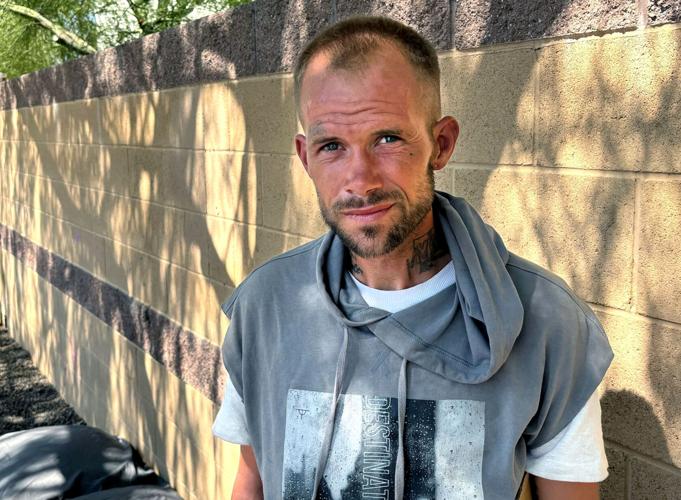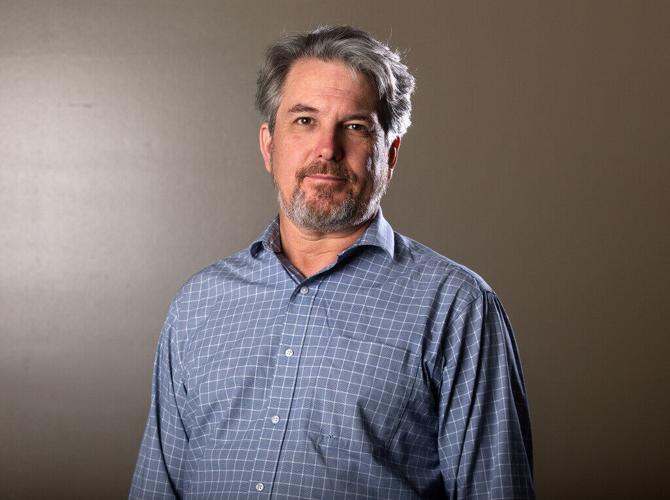You’ve seen people like Wallace Leight, Lindsay Romeo and Amelia Kyewski around Tucson.
You see them along the streets, in the culverts, beside the washes, doing drugs. Tucsonans generally call them “homeless” and don’t like seeing them around, which is understandable as the groups of users multiply all over town.
As I was talking with Leight and Romeo near East Speedway and North Craycroft Road Thursday, a work truck with men in fluorescent green shirts slowed down, and one of them shouted “Hey, hey, what’s the drugs like today?!”
It’s a degrading life, but not the only one possible for these people. Leight, 36, worked as a machinist back in Michigan, he told me. Romeo, 31, has managed an IHOP and worked at a new-car dealership in town, she said. Kyewski, 35, was one course short of a nursing-assistant’s certification up in Phoenix.

Arizona Daily Star columnist Tim Steller
“When the blues came around it (messed) up my whole world,” Kyewski said, referring to the blue street pills containing fentanyl.
They all could make it in this world. Some of them have had periods off drugs. But they need a sobriety that sticks — so hard in this city awash in drugs and in this state and country where it’s not easy to get a long, strong run of treatment.
I think about that every time I hear about labor shortages in medical jobs, in the trades, in food service, or in other fields. The Americans who could fill those jobs are out there. Many long for the chance to do those jobs.
But standing in the way are the immense obstacles of a detox that may be tortuous, of getting into a solid treatment program that works, and of landing housing and a paycheck right away afterward to help them avoid relapsing.
When I asked Romeo what she would most need after getting off drugs, she said, “For me it would be a job and housing. If you’ve got a job, you can have a routine.”
Finding a routine
The Haven is one of the many places in Tucson and Arizona where people who have substance abuse disorder can start to find that alternative routine. It’s got a rambling campus in midtown where women learn the skills to steer away from old habits and toward new ones.
CEO Aimee Graves and Vice President Emilia Honkasaari told me that running it is getting harder, though. One issue is the new covered-service guide produced by the state’s Medicaid system, AHCCCS.
AHCCCS produced this new version of the guide after being defrauded by an amount that may top $1 billion by people operating sober-living homes and behavioral-health residential facilities from about 2018 to 2022. The new guide tightens billing requirements so the system doesn’t get defrauded like that again.
For example, Honkasaari explained, now it doesn’t allow a provider to charge for a patient’s intensive-outpatient group session and individual treatment on the same day, even though both might be what the patient needs that day. And group sessions are capped at 12 people, although that may be too few patients per group to pay the provider’s costs.

Wallace Leight, 38, said he worked as a machinist in Michigan before moving to Tucson and getting hooked on drugs again. He’d like to shake the habit but hasn’t made it yet. “I don’t want to live off the system,” he said.
Graves called it “good-intentioned overcorrection making it harder for community-based providers to even keep their doors open.”
An AHCCCS spokeswoman told me in a statement: “AHCCCS is working closely with the behavioral health provider community as they’ve needed to adjust billing practices to comply with existing standards and new processes put in place to reduce fraud.”
Beyond Medicaid, other health plans are also becoming stingier — my word, not theirs — even as the need remains vast.
“Ninety days used to be the standard. Now it’s shorter,” Honkasaari said, referring to changes over the last year or two.
Thirty days is a common limit, with the provider needing to give the insurance company updates and justifications for continuing treatment after 14 days.
“Recently, we’ve had to add a lot of paper to prove medical necessity,” Graves said.
Wide range of treatment
Romeo seemed remarkably clear-headed when we were talking, amid a group of drug users, and told me she’s had a range of treatment experiences. When she was still on her parents’ insurance, she was able to go to Sierra Tucson for 28 days.
“It’s a huge difference when you’re in a resort setting and wealthy people vs. being crowded in CBI with the lowest of the low,” she said, referring to Community Bridges Inc., a local behavioral-health agency.
She wasn’t judging those CBI clients so much as noting how the relative luxury of Sierra Tucson helped. She got sober for a good while then, with the help of her probation officer. But it hasn’t stuck.
As she talked, Leight, who was smoking meth when I arrived 15 minutes before, got agitated waiting for his friends.
“We need to go,” he said. “I need some heroin. I need to get well.”

Romeo
Leight had told me he worked as a machinist in Michigan and was sober for four years there but got hooked again when he came out here. Imagining going through detox is scary, he said, because he’s had seizures and other bad experiences when detoxing before. But he imagines a better life.
“I don’t want to live off the system,” Leight said.
After talking with Leight, Romeo and others using drugs near Craycroft and Speedway, I headed over to another hotspot — North Oracle Road near West Fort Lowell Road. I decided not to venture into the culverts but talked with a group that included Kyewski and a man named Anthony, who didn’t give me his last name when I asked him about getting off drugs.
“We’re like little babies,” Anthony said. “We need a lot of attention and a lot of help.”
Then things deteriorated. There was a dispute between Kyewski, Anthony and another man involving a “torch” (lighter) that escalated into the two men shouting at each other, and one large rock thrown that hit nobody. I said my goodbye.
A barrier to giving help
People often complain that nobody is doing anything about all the street people in Tucson. That’s not at all true. Daily, many people, in and out of government, are working hard on a problem that is increasingly intractable.
The days when social workers could walk up to a camp full of “homeless” people, offer services, and hope to snag some takers are over. Most of the eager people accepted long ago.
Mari Vasquez, the city and county’s homeless-response coordinator, told me she’s seen a change over the last year or so.
“What we’re seeing currently has changed from more of a housing need to something that’s starting with the substance use being a barrier to us even starting with those housing conversations,” she said. “It’s become a lot more challenging for outreach, that’s for sure.”
If people with drug problems are convicted of crimes, Pima County’s longstanding drug court can offer an alternative to time wasted in prison: An 18-month program of treatment and education.
Pima County also has the new transition center located just outside the jail. It’s staffed by people with experience of overcoming addiction or related problems who give help to people looking for it.
The idea, said Kate Vesely, director of the county’s Department of Justice Services, is to “redirect people to housing, employment, treatment, a family support system. Anything to avoid going back to the encampment or going into the neighborhood around the jail.”
The addiction struggle
As I departed the hangout on North Oracle Road, I noticed a couple of employees of a nearby business talking outside and looking at me. I told them what I’d been doing, asking people about the obstacles that keep them from getting off drugs.
They were unimpressed. It turns out that both, separately, had their own addiction experiences — one on methamphetamine, the other on alcohol and cocaine. One got off meth by spending years in prison. The other got off alcohol and cocaine in part when friends locked him up to keep him from using, and then when he went into the Army.
Both did it on their own, they said. And both said what keeps them from relapsing is the risk of losing the lives they’ve built.
It’s true that in the end, people addicted to drugs and alcohol have to make it themselves. But it is harder than most of us can imagine.
Not everybody has the wherewithal to do it on their own. And those who can’t will be our problem until they either get incarcerated, die, or get better. We’re all better off if they can overcome their addictions and fill a productive role in society.
That’s why we need a generous system that makes it as easy and comfortable as possible to take those painful steps.






